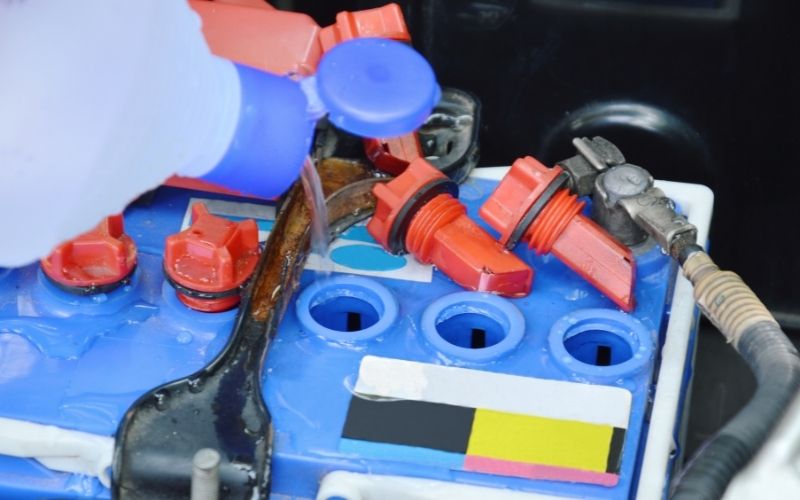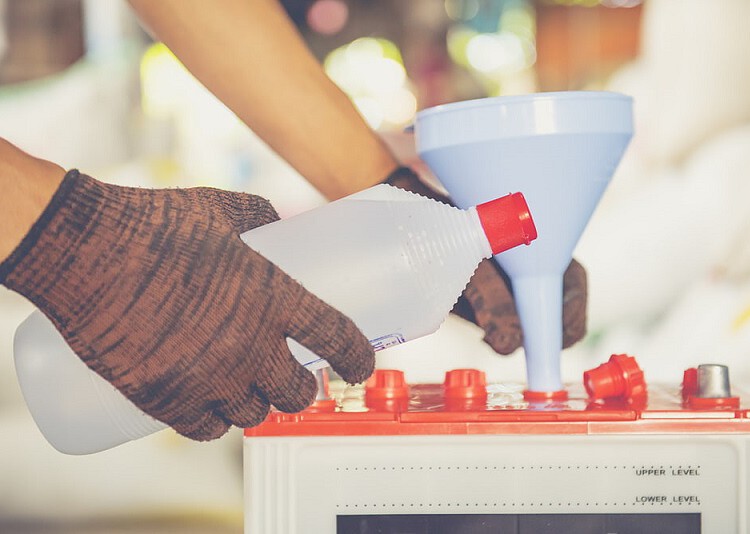You’ve peeked into your marine battery and noticed the water level seemed a bit low.
Whether you are brand new or you’ve owned a boat for a few months, you are probably wondering if you need to add water to a marine battery.
For most marine battery types, you do need to add water to them. Proper water levels will keep your battery in tip-top shape for the remainder of its life.
Besides the necessity of adding water to a battery, you might also be curious about how to add water to a marine battery and how often. In this article, we will answer all your questions and give you a bonus of what could happen if you don’t put distilled water in a battery.
Table of Contents
Do you Have to Add Water to a Marine Battery?

Whether you add water or not to a marine battery is all dependent on the type of battery you have. The type of marine battery that requires you to add water to it is the flooded (wet cell) lead-acid battery.
Absorbed Glass Mat (AGM), gel cell, and lithium marine batteries do not need to be watered. Their battery constructions make it so you don’t have to add water or refill them.
Flooded marine batteries or wet cell batteries are unsealed and unlike the other battery types, use an electrolyte liquid or sulfuric battery acid reservoir. It will require periodic inspection and you must add distilled water to the cells from time to time.
The reason you must fill it with distilled or deionized water and not tap water is that the minerals in tap water can be harmful to a flood wet cell battery. Distilled water is inexpensive and is a cheaper option than having to replace an entire battery!
How to Add Distilled Water to a Marine Battery?
You’ll want to check the water level when the flooded marine battery is fully charged. To do this, you will need to open the vent well and look down into the holes. A flashlight can be super helpful here!
If the water is below the plates and the max fill line, then you will need to add distilled water to your battery. Wear your personal protective equipment (PPE) gloves and eye protection before you start adding distilled water to the battery.
Add distilled water an inch on top of the battery, or ⅛ inch below the bottom of the fill well, or just below the maximum water fill line for batteries with a built-in indicator.
You can simply pour distilled water from a water bottle or you can use a marine battery filler bottle to assist in funneling distilled water through the vent well and into your battery. Some battery fillers come with an automatic shut-off to assist you with proper water levels.
After you’ve gotten the water level to the appropriate level, replace the vent well caps and wipe down any dropped water on the top of the battery.
Some important tips and cautions when filling your flooded battery with distilled water are:
- Don’t let the plates get exposed to air
- Don’t fill the water level to the cap
- Don’t use water with a high mineral content
- Avoid direct skin contact with the sulfuric acid liquid inside the battery
- Never add acid to a battery
Where to buy distilled water for batteries?

Luckily for you, you can buy distilled or deionized water at just about any store. There isn’t a “special” distilled water that you need to use, you can use any brand of water as long as it is distilled or deionized.
Here is a list of stores you can buy distilled water for batteries:
- Grocery stores and supermarkets
- Pharmacies
- Gas stations
- Amazon
- Water delivery stores
How Often Do You Add Water to a Marine Battery?

The frequency of adding water to a flooded wet cell marine battery depends on how often you use your battery. You should check your flooded battery water levels every 4 – 6 weeks, at least once a month, to see if the water level has dropped.
In general, most people find themselves topping off the water level in their marine battery every couple of months. Again, you may need to do it monthly or quarterly depending on how frequently you use the battery.
What Happens if You Don’t Put Distilled Water in a Battery?
If you don’t put distilled water in a battery the water levels will drop below the battery lead plates, leaving them exposed which leads to battery corrosion. You may be wondering how exposed batteries corrode, let us explain.
Flooded wet cell lead-acid marine batteries hold flat lead plates that are immersed in an electrolyte solution consisting of water and sulfuric acid. Water is necessary for this type of battery.
During the battery recharging process, electricity flows through the water and converts into hydrogen and oxygen. These gasses are highly flammable and cause water loss which is why you need to put distilled water in your battery periodically.
Distilled or deionized water is recommended because it is free from additional minerals. You can significantly decrease a marine battery’s life when you add chemicals and minerals.
Some people fill their flooded wet cell batteries with tap water and even lake water because it’s cheap and the “lazy man” option. But we strongly advise against this if you want your battery to last for a long time.
Summary
The main type of battery that requires you to have to add water to it is a flooded (wet cell) lead-acid battery. Other battery types do not have this water requirement because they are either sealed or have mechanisms in place inside the battery to handle its processes differently.
You now understand the importance of why we use distilled or deionized water to fill flooded batteries and you know how to do it. With your monthly water level checks, you will extend the life of your battery and be prepared for your next journey.

Amazon best-selling author & coauthor, Misty Compton is an outdoor enthusiast, raised on water sports, fitness, and writing. CEO of two companies, Daggerwing Publishing House LLC and Organized Otter Administrative Support LLC, she writes and edits content providing great reads, and assists companies remotely by helping them get organized.

